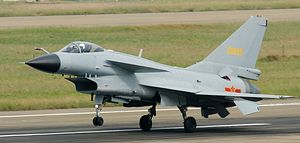China allegedly has agreed to sell 150 J-10 multirole fighter jets to Iran, the Israeli military intelligence website DEBKAfile reported last week.
“Beijing has agreed to sell Tehran 150 of these sophisticated jets,” the website states, based on information obtained from unnamed intelligence and military sources.
No public officials from either country have denied or confirmed the weapon deal so far. It is also unclear whether the purchase would include the Chengdu J-10A or the modern J-10B version of the plane.
However, according to other media reports earlier last month, Beijing is considering selling the J-10B fighter to potential customers in in Asia, Africa, and Latin America. Pakistan reportedly already signed a deal for the purchase of 36 J-10A jets in 2009.
The single-engine Chengdu J-10 is a multirole fighter jet that first entered service with the Chinese air force in 2004 and is purportedly comparable to the U.S. F-16. “The J-10 was a tricky aircraft to build and was beset by numerous design flaws, including a notable failure in its fuel system in the late 1990s,” a War is Boring contributor noted. There have been persistent rumors that the J-10 is a replica of Israel’s cancelled Lavi fighter jet prototype. One analyst reported in 1996 that “after Israel discontinued the largely U.S.-funded project, it sold China the plans for the Lavi and the associated secret U.S. technology.”
The Chengdu Aircraft Industry Group started mass producing the J-10B version of the aircraft last year. Today, at least ten fighter jets are currently in service with the People’s Liberation Army Air Force (PLAAF) undergoing flight testing. The Chinese air force wants to stand up an entire J-10B fighter jet regiment consisting of 24 aircraft by the end of 2015. There are currently around 270 J-10A in active service with the PLAAF. China Military Online explains the difference between the two versions:
The J-10A fighter is mainly used for territorial air defense, namely [to] intercept and expel the planes which have invaded China’s territory. “While the J-10B fighter, as a type of multi-purpose fighter, can not only undertake the territorial air defense tasks, but also carry out active attack,” Zhang [Zhang Zhaozhong, a military expert at China’s National Defense University (NDU)] analyzed.
According to Chinese aviation experts, the J-10B is 30 percent better than the J-10A in overall performance. IHS Jane’s Defense Weekly summarizes in detail key improvements in the upgraded version of the plane:
The J-10B’s key differences from the J-10A include a redesigned chin intake, with the lower edge now angled forward and movable ramp replaced by a smaller, fixed, diffuser bulge that also contributes to reduced weight and radar cross-section; a longer nose radome that is believed to house an NRIET active electronically scanned array radar; and an electro-optic targeting sensor (infrared search and track, and laser rangefinder) mounted just forward of the windscreen, offset to starboard. It also has a new electronic warning or countermeasures pod atop the vertical stabilizer.
It remains unclear whether the newer batches of J-10B aircraft will be powered by the Chinese WS-10 turbofan engine or the Russian AL-31FN M1 engine. The J-10As are all equipped with less powerful AL-31F engines.
Both versions of the plane have an in-flight refueling capability. The J-10 also has beyond visual range air combat and surface attack capabilities. According to Popular Science, the aircraft “can carry both 100km ranged PL-12 air to air missiles and LS-500J laser guided bombs on the same mission. These advanced ‘4.5+ generation’ features places the J-10B in the same class as the F-16 Block 60 (flown only by the UAE), French Rafale, and Eurofighter Typhoon.” Both versions of the J-10 are also armed with a single-barrel 23-mm cannon.

































